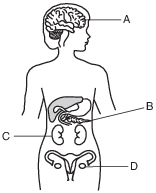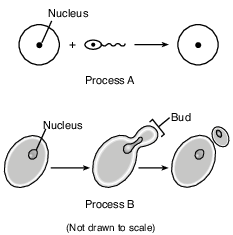Topic: Sexual Reproduction
Sexual Reproduction
Female mosquitoes spread diseases when they bite humans to obtain blood. It is only the females that do the biting. Research is being conducted to alter the DNA of male mosquitoes. These altered males could then mate with normal female mosquitoes. All of the resulting female offspring would have wing defects that prevent them from flying.
One assumption from this research is that the
(1) altered males would begin to bite humans and spread the diseases
(2) female offspring would be unable to bite humans, since they cannot fly
(3) altered males would not be able to reproduce
(4) female offspring would become larger in size
A significant difference between the effects of the genetic information passed on from asexually reproducing parents to their offspring and sexually reproducing parents to their offspring is the
(1) degree of modification of the size of chromosomes
(2) types of DNA subunits
(3) number of chromosomes in the body cells of the offspring
(4) amount of variation between the parents and the offspring
Some organs in the human body are represented in the diagram below.

A sudden change in the DNA of cells developing in which organ could be passed to future generations?
(1) A
(2) B
(3) C
(4) D
Two kittens in a litter are genetically different from each other and from their parents. These genetic differences are most directly due to
(1) sexual reproduction
(2) asexual reproduction
(3) cloning
(4) evolution
Which diagram correctly represents a step in the normal process of human reproduction?

(1) 
(2) 
(3) 
(4) 
Which expression correctly represents a repro- ductive process that usually occurs in humans where 2n is equal to the number of chromo- somes in each body cell?
(1) n + n → n
(2) n + n → 2n
(3) n + 2n → 2n
(4) 2n + 2n → 4n
Some variation must be present in a population in order for natural selection to take place. These variations arise from mutations in the DNA and
(1) sorting of chromosomes during sexual reproduction
(2) combining of chromosomes during organ development
(3) changing of chromosomes during cloning
(4) removal of chromosomes during selective breeding
A human skin cell contains 46 chromosomes. A frog sperm cell contains 12 chromosomes. Which pair of numbers shows the chromosome number of a normal gamete from each of these species?
(1) human 46; frog 12
(2) human 46; frog 24
(3) human 23; frog 24
(4) human 23; frog 12
The hair colors of the members of a family are listed below.
mother – brown hair
father – blond hair
older son – brown hair
younger son – blond hair
The hair colors of the sons are most likely a direct result of
(1) natural selection in males
(2) heredity
(3) evolution
(4) environmental influences
The diagrams below represent two reproductive processes used by different organisms.

When compared to organisms that utilize process A, organisms that utilize process B would most likely produce offspring with
(1) a greater variety of genetic combinations
(2) fewer genetic differences
(3) more genetic combinations
(4) more DNA within each nucleus
A female giraffe has 62 chromosomes in each of her skin cells.

How many chromosomes will be in the skin cells of her offspring?
(1) 124
(2) 62
(3) 31
(4) 30
All organisms need to reproduce for the continuation of their species. Discuss the process of reproduction in humans. In your answer, be sure to:
• identify one hormone present in a female that is involved in regulating the reproductive cycle [1]
• state one way the nucleus of a sex cell is different from the nucleus of a body cell [1]
• state how the normal chromosome number for humans is maintained from one generation to the next [1]
• identify one action by the mother that can influence the development of the embryo and state a result of that influence [1]
The student’s response to the bulleted items in the question need not appear in the following order.
• 12 Allow 1 credit for identifying one hormone present in a female that is involved in regulating the reproductive cycle. Acceptable responses include, but are not limited to:
• — progesterone
• — estrogen
• — LH
• 13 Allow 1 credit for stating one way the nucleus of a sex cell is different from the nucleus of a body cell. Acceptable responses include, but are not limited to:
• — It has half the normal chromosome number/half of the genes.
• — Sex cells are haploid/monoploid.
• — 23 chromosomes in sex cells, 46 in body cell
• 14 Allow 1 credit for stating how the normal chromosome number for humans is maintained from one generation to the next. Acceptable responses include, but are not limited to:
• — The egg and sperm each have half the normal chromosome number, and when they join, it restores the normal number for the species.
• — through the process of gamete production and fertilization
• — Each parent contributes half of the chromosomes.
• 15 Allow 1 credit for identifying one action by the mother that can influence the development of the embryo and stating a result of that influence. Acceptable responses include, but are not limited to:
• — Alcohol use can lead to Fetal Alcohol Syndrome.
• — Smoking can lead to low birth weight.
• — Poor nutrition can lead to underweight babies.
• — Drug use can lead to birth defects.
• — Good nutrition can lead to a healthy baby.
• — Drinking alcohol puts the embryo at risk.
• — Proper prenatal care might detect potential problems early so they can be treated.
Twins Don’t Share Everything
…Chemicals called epigenetic markers can be attached to those [inherited] genes, like flags or balloons hanging off the sides of the DNA ladder. These don’t just change the look of the genes. Like pieces of tape stuck over a light switch, these markers can force a gene to remain turned on or off. The type of marker scientists studied in the twins generally sticks the switch in the off position so that some proteins don’t get made. And that means the proteins’ jobs won’t get done.
Every time a cell divides, new epigenetic markers may form. Foods, pollutants, and stress may all contribute to the development of new markers. So throughout our lives we tend to accumulate more and more. But a few are there from the day we’re born.
…His [Jeffrey Craig’s] team found that newborn twins have markers attached to different genes from the very start. It’s true in identical twins, which come from the same fertilized egg. It’s also true in fraternal twins, which come from different fertilized eggs. However, fraternal twins had more such differences than identical twins did.
Source: Science News for Students; July 31, 2012
Explain why the genetic material in an offspring produced by sexual reproduction contains genetic material that is not identical to the genetic material of either parent. [1]
Allow 1 credit. Acceptable responses include, but are not limited to:
• — Offspring receive genetic information from each of two parents.
• — Each parent contributes half of the offspring’s genetic material.
• — Recombination of genes occurs at fertilization.
• — may be due to mutations
• — meiosis and crossing over
The testes of a human male produce gametes. The process that produces these gametes differs from the process that produces new skin cells in the same individual.
How does the genetic makeup of the skin cells differ from the genetic makeup of the gametes? [1]
Allow 1 credit. Acceptable responses include, but are not limited to:
• — Skin cells contain the full number of chromosomes for the individual. Gametes contain half
• the number of chromosomes.
• — Skin cells of an individual are normally genetically identical and gametes have variation.
• — Skin cells = 2n/46/diploid; gametes = n/23/haploid.
• — Skin cells have twice as much genetic material.

A few breeds of cat have no tails. Manx cats have extremely short tails and may even appear to have no tail at all. Manx cats were first discovered several hundred years ago.
Scientists have determined that a certain mutation in a group of genes (called T-box genes) interferes with the development of the spine in the cat embryo. Mutations in these T-box genes can cause abnormalities in the number, shape, and/or size of bones in the spines of Manx cats, which results in smaller spines and shorter tails.
If a Manx cat inherits one copy of the mutated T-box gene and one copy of the normal gene, it will have a very short tail or no tail at all.
If the cat embryo inherits two copies of these mutated genes, it will stop developing and die. Therefore, all surviving Manx cats have only one copy of the mutated gene.
Two Manx cats have several litters of offspring. Explain how the genes that the kittens inherit determine whether they will have a normal tail or a short tail. [1]
Allow 1 credit. Acceptable responses include, but are not limited to:
• — If a kitten gets one mutated gene from one parent, it will have a short tail or no tail.
• — If it gets a normal gene from each parent, it will have a normal tail.
• — Each parent has a Manx gene and a normal gene, so kittens will be born with Manx tail
• traits or normal traits, depending on whether they inherit one or two normal genes.
